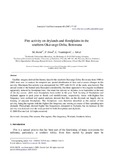Please use this identifier to cite or link to this item:
http://hdl.handle.net/10311/151Full metadata record
| DC Field | Value | Language |
|---|---|---|
| dc.contributor.author | Heinl, M. | |
| dc.contributor.author | Frost, P. | |
| dc.contributor.author | Vanderpost, C. | |
| dc.contributor.author | Sliva, J. | |
| dc.date.accessioned | 2008-07-03T10:22:39Z | |
| dc.date.available | 2008-07-03T10:22:39Z | |
| dc.date.issued | 2006-05-08 | |
| dc.identifier.citation | Heinl, M. et al. (2007) Fire activity on drylands and floodplains in the southern Okavango Delta, Botswana, Journal of Arid Environments 68. pp. 77- 87 | en |
| dc.identifier.issn | 0140-1963 | |
| dc.identifier.uri | http://hdl.handle.net/10311/151 | |
| dc.description | The study was part of the project 'Fire regime and vegetation response in the Okavango Delta, Botswana' funded by the Volkswagen Foundation, Germany and carried out by the Chair of Vegetation Ecology, Technische Universitaet Muenchen, Germany in collaboration with the Harry Oppenheimer Okavango Research Center (HOORC, University of Botswana) and University of Pretoria, South Africa. Financial support was also given by Conservation International Botswana and the German Academic Exchange Service (DAAD). | en |
| dc.description.abstract | Satellite imagery derived fire history data for the southern Okavango Delta, Botswana from 1989 to 2003 were used to analyse the temporal and spatial distribution of fires and to assess changes in fire activity. Maximum fire activity was encountered for 1997 with 24.1% of the study area burned. The annual extent of the burned area fluctuated considerably, but there appeared to be a regular oscillation apparently induced by floodplain fires. The main fire activity on drylands is in September at the end of the dry season, while most floodplains burn earlier in the year. Both burning of floodplains and drylands appear to peak prior to floods and rainfall-events, respectively. Areas with highest fire frequency were outlined and spatial analyses showed that fires on the drylands are largely due to burning of adjacent floodplains. The floodplains were therefore identified as the centres of fire activity, being the regions with the highest fire frequency and serving as source of fires spreading into drylands. Floodplains showed higher fire frequencies compared to drylands, but no increase in fire activity was detected over the study period for both floodplains and drylands. | en |
| dc.language.iso | en | en |
| dc.publisher | Elsevier; http://www.elsevier.com/wps/find/journaldescription.cws_home/622855/description#description | en |
| dc.subject | Savanna | en |
| dc.subject | Fire season | en |
| dc.subject | Fire regime | en |
| dc.subject | Fire frequency | en |
| dc.subject | Wetland | en |
| dc.subject | Southern Africa | en |
| dc.title | Fire activity on drylands and floodplains in the southern Okavango Delta, Botswana | en |
| dc.type | Article | en |
| Appears in Collections: | Research articles (ORI) | |
Files in This Item:
| File | Description | Size | Format | |
|---|---|---|---|---|
| heinl_j_arid_env.pdf | 383.71 kB | Adobe PDF |  View/Open | |
| license.txt | 1.95 kB | Text | View/Open |
Items in DSpace are protected by copyright, with all rights reserved, unless otherwise indicated.
